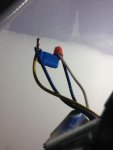I find this interesting and of course puzzling at the same time!
Hurk27, do you have to install a RFI filter at every light or could one just introduce
this product at the beginning of all the individual branch circuits? My assumption is that
it would need to be at each ballast?
I'll assume this individually would be required but you later state later in post #3 that it really doesn't matter because the RFI filter doesn't work against the stronger generation produced from within newer individual ballast! So only with correct detection tools would one know that in fact there is no correct action to be gained using a RFI Filter?
It there an consideration made where one needs to consider checking that the correct Grounding of the structure that is in place and that it in effect, if not correctly grounded adds to the effects of RFI noise. I'm thinking of older structures and even older power applications of delta systems that do enter building UN-grounded.
Does adding this RFI filter add to any consideration to add some factor to non linear loading that are associated to florescent light usage?
I looked up
RFIfilters, care to state which models you use? I realize they might be some different characteristic's of each but that you probably have a few favorites! I found it interesting that they had both parallel and what looked like inline or series equipment,
and others had in & out terminalson others!
With in-line in mind leads me to a presentation and a application I did on small refrigeration valves. Working for a refrigeration mechanic he told me to install a resister (blue) between the circuits because the signal was to strong to the littlevalves and this added in the valves life-span. I did not ask many questions about the resister and he was not much enlightenment, and just did what he stated! Frankly I'm not even sure it was a resistor!
Hurk would you ever install something like this on a light circuit? As I recall this was 120V
actuactors.
View attachment 10029View attachment 10030



